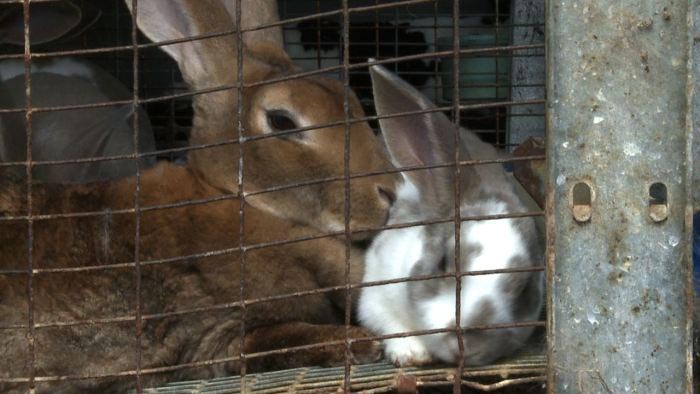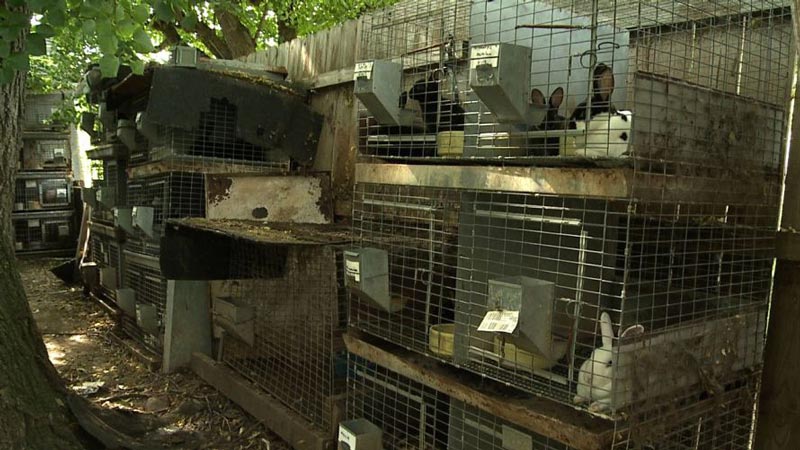Rabbit Mills &
Pet Store Cruelty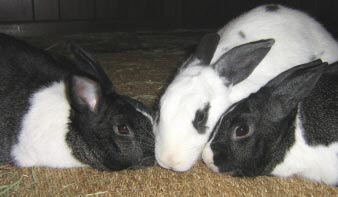
March 2008: Petland and
other stores continue to cash in on the invented Easter/rabbit connection by
selling rabbits for Easter while adorable, completely adoptable homeless rabbits
are being killed in shelters every day. Rabbit Rescue of California
estimates that 95% of all rabbits that enter shelters are killed there.
Video:
http://www.youtube.com/watch?v=LE-xib5psJU&NR=1
Friends of Rabbits, a D.C. area rescue group, as well as other groups, have made
videos explaining the plight of rabbits. With the
incredible variety of rabbits available and the horrendous slaughter of these
animals at shelters, why in the world would anyone want to add to this problem
by buying a mill-bred rabbit from a pet store?
At this writing, our local Petland has approximately 16 baby bunnies for sale.
Ever wonder where that constant supply of babies comes from and what happens to
them when they get a little older? See the articles below for details of the
cruel rabbit mill industry. Many people who buy rabbits from pet stores don't
know that rabbits are sensitive animals that require special care if they are to
thrive and be happy. Many homeless rabbits are available for adoption, and
nonprofit groups offer excellent advice on how to care for bunnies. (See links
below.) Petland, in contrast, sells a small cage called a Rabbitat to go along
with the bunnies. Clever title, but confining rabbits to a space that small
subjects them to LIFELONG MISERY. Rabbits have strong jumping legs! How can they
do their happy bunny dance if they have no room to move? They need, at a
minimum, the space provided by a metal exercise pen, simple to set up and
readily available at pet stores. Preferably they should be allowed to run, play,
and chew lots of hay in entire rabbit-proofed rooms.
2007: GREAT NEWS! After Much public outrage, Petsmart has decided not to
sell rabbits after all. Now it's time to get Petco to do the same. Wherever you
live, please campaign to stop sales of rabbits in pet stores, flea markets, and
other public places.
UPDATE:
Richmond, CA (November 17, 2008). House Rabbit Society (HRS) is delighted to
announce that Petco has decided to cease its sale of rabbits in all Petco
stores. Petco will begin phasing rabbits out of its stores immediately and as of
early 2009, the only rabbits available at Petco stores should be rabbits from
shelters or rescue organizations.
February 2007: Petco Refuses to Stop Selling Rabbits. Their position:
"Thank you for your comment about the adoption and sale of rabbits in our
stores. I am writing to explain Petco's approach to helping find homes for
shelter rabbits and also to meeting the needs of pet parents wishing to have
rabbits as companion animals.
Our approach is founded on our company's Think Adoption First philosophy, in
which we encourage customers to adopt, rather than to purchase, companion
animals. In fact, Petco is an important conduit to link rabbits--the country's
most popular companion animals--with responsible pet owners. We have an open
offer to rescue groups nationwide to make their shelter rabbits available to
Petco customers through our stores--and in doing so, to help save shelter
rabbits from euthanasia.
These rescue group arrangements, which we have in place in several areas of the
country, are an effective way to find responsible homes for shelter rabbits. In
stores where a local shelter is able to provide a consistent supply of shelter
rabbits, we will not offer for sale rabbits from any other source.
We would like nothing more than to develop enough rescue group partnerships to
fulfill all customer demand with shelter-provided rabbits. However, that is not
the case today. In stores where no rescue group is able or willing to provide a
consistent supply of shelter rabbits, we reserve the right to offer for sale
rabbits obtained from other sources to meet the needs of responsible customers.
Please also know that all rabbits offered for sale or adoption through our
stores are required to be spayed or neutered.
We believe our approach, combined with a price point unlikely to lead to impulse
decisions, is a responsible and reasonable way to connect shelter rabbits with
people committed to providing appropriate care, and at the same time meet
customer desires for rabbits as companion animals.
Thank you again for your inquiry.
Sincerely,
Julie M. (last name not included in letter)
Customer Relations Coordinator
PETCO Animal Supplies, Inc.
Now that Petco has decided NOT to sell rabbits anymore, please thank them.
RAISING RABBITS -The Plight of Pet Rabbits,
courtesy of Margo DeMello, director of the House Rabbit Society
It's hard to know exactly how many pet rabbit breeders exist in the United
States today, or how many rabbits are bred by this barely-regulated industry.
According to an industry survey, at least 20,000 men and women breed rabbits for
the pet market, but that is certainly an underestimate, and does not include all
those meat rabbit breeders who sell to the pet market as well. Pet rabbit
breeders range from the small backyard or hobby breeders to sophisticated show
breeders, to very large commercial rabbitries, or "rabbit mills" with conditions
very similar to the more widely known puppy mills. These large commercial pet
rabbit breeders sell large numbers of rabbits at wholesale prices directly to
pet stores, or through wholesalers who act as middlemen. Many smaller breeders
do not have the facilities for such a large-scale operation, so they sell
directly to the customer or to small, local pet stores. But customers who
purchase a rabbit at a chain pet store like Petland or Petco are most likely
buying a rabbit who was bred at a rabbit mill, and sent to the store via dealers
who transport rabbits, puppies, kittens, and other animals from breeder to pet
store.
Like the puppy breeding industry, the pet rabbit breeding industry is rife with
cruelty. From the breeding process itself (with large numbers of babies being
culled if they do not conform to breed standards) to the joyless and solitary
life led by the breeder rabbits, to the dangerous transport of often un-weaned
babies across the country (leading to 20-30% of deaths during transport alone),
and finally to the conditions at the pet store itself (where, due to notoriously
poor conditions and little to no staff training in rabbit care, another 20% of
baby rabbits can be expected to die), rabbits bred for the pet industry are
lucky to even make it to a home.
Once a customer, usually upon impulse, decides to purchase a rabbit, they can
expect to bring home an animal who the staff has either not sexed or has
incorrectly sexed, and they will, most likely, receive no educational
information on how to care for their new rabbit. Most will not know that rabbits
can be litter box trained, and will purchase a wooden hutch for the rabbit to
live a short and lonely life outdoors. Others may know that rabbits can live
indoors, but will not be informed of the need to bunny proof their house, and
once the rabbit demonstrates their natural need to chew, will be placed outside,
given away, or surrendered at a shelter. No pet store that I know of provides
any sort of pre-sale counseling and education to potential purchasers, setting
up the stage for the rabbit to live an unhappy life with a family who was not
prepared for his needs.
How many rabbits are produced by this industry? Again, no reliable numbers can
be found, but House Rabbit Society representatives around the country, along
with other rabbit rescue groups and the city and county shelters which take in
rabbits all will verify the same thing: rabbits are surrendered at shelters and
then euthanized in alarming rates. And there are thousands more rabbits who are
not brought to shelters, but instead are abandoned in parks, woods, golf courses
and college campuses, where these domestic animals will often reproduce before
their deaths by car, dog, or wild animal. The rabbit breeding industry
contributes to the problem by breeding rabbits indiscriminately for sale in pet
stores and other venues, providing little to no education with their sales, and,
ironically, disputing the fact that a problem with overpopulation or homeless
rabbits even exists.
THE RABBIT BREEDING
AND RAISING PROCESS
By Cheryl Kucsera, The
Monaco House Rabbit Sanctuary
Rabbits, among the most exploited of animals, are viewed by breeders as
livestock. The majority of them are raised for meat and/or fur. Many are raised
for exhibition, while many others are raised to be used in animal research. The
number of rabbits who end up as companion animals is small in comparison to the
number raised for these other "uses." Many people don't realize that companion
rabbits are of the same breeds that are exploited for meat, fur, exhibition and
research.
The operation in which rabbits are raised is called a rabbitry. Most people
outside of the rabbit breeding community have never seen a rabbitry. The
rabbitry closely resembles a battery hen operation, with row after row of wire
cages, often stacked. The rabbits spend their entire lives on wire bottom cages,
which often cause sores on their feet and possibly broken toes from getting
caught in the wire. Except for mother rabbits with babies, each rabbit lives
singly, in its own small, wire cage. Female rabbits are bred repeatedly. When
they are no longer productive enough to suit the breeder's standards, they will
be culled from the rabbitry. The fate of many of the rabbits culled from the
rabbitry will be slaughter (for human consumption); others may be sold as food
for reptiles or other animals.
Before and during the Easter season, consumer interest in baby bunnies is at its
peak. In order to exploit this demand, many rabbit breeders will schedule the
breeding of their rabbits so that extra litters of baby bunnies will be
available at this time. In pet store terms, baby bunnies don't have a long
"shelf life." This is because they grow so very quickly. Therefore, in order to
meet pet stores' desires for the "cutest" baby bunnies, some breeders may supply
bunnies who are too young (under 8 weeks of age). I was told of one breeder/petmiller
who supplied baby bunnies to local pet stores. Every few weeks, when he would
drop off a new "shipment" of baby bunnies, he would pick up any that hadn't sold
from his previous shipment. According to him, if the bunnies hadn't been
purchased at that point, they never would be. So, he took them back to his home
where they ended up in his freezer. He said it was more "humane" for them to end
up on his plate than to languish in a cage in the pet store!
Rabbit mills exist, but the conditions and quality of life that exist in
"reputable" rabbitries aren't very rabbit friendly, either, since life in the
rabbitry cruelly deprives rabbits of the opportunity to live according to their
natures. Domestic rabbits are descendants of wild European rabbits, highly
sociable animals who live in colonies with a sophisticated social hierarchy.
Domestic rabbits still retain the social nature of their wild cousins, but life
in the rabbitry denies them any opportunity to form bonds with other rabbits, or
to engage in behaviors such as mutual grooming or playing. With European
rabbits, the father rabbit takes a very active role in raising and nurturing the
babies, but this, too, is denied domestic rabbits since the only contact the
parent rabbits have is when they are put together to mate.
Regardless of the total number of rabbits in the rabbitry, it is a very sad,
lonely, boring and stressful existence for its inhabitants. There is no shortage
of homeless rabbits! An uncountable number of rabbits are euthanized in animal
shelters each year. With so many deserving rabbits being destroyed, how can
anyone justify purchasing a rabbit from a breeder or a pet shop? And as long as
perfectly healthy and wonderful animals are being destroyed in shelters, how can
anyone justify bringing another litter into this world? Adopt a homeless animal
and save a life!
EASTER BUNNY NOT THE PET YOU THINK IT IS
By Lorraine Nicotera. This article appeared in the Weymouth News
(Massachusetts paper) Wednesday, March 9, 2005.
When I was a kid, for Easter my parents bought all us kids a little black bunny
who we named Fluffy. We all loved her and we passed her around and petted her
and fed her carrots and we were thrilled. Eventually, like kids do, we lost the
initial interest and cleaning and caring for her became a chore. She was
designated first to the basement, then, because of the smell (we were not
diligent in cleaning up after her) the garage, a cold, dank, light-less building
filled with old junk and engine parts. We reluctantly cleaned her cage maybe
once a week and she lived on a wire-bottomed cage on pellets, and sometimes,
when we were lax (as children can be) in her own feces. She died a couple of
years later--on a cold, winter morning I found her in her cage when I, just by
chance, wandered into the garage.
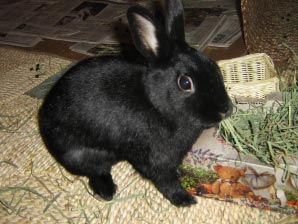
I dedicate this column to her.
In the days leading up to Easter, rabbits appear on television commercials and
packages of candy, and stores are filled with stuffed rabbits. It is no surprise
that children beg their parents for a bunny of their own. Ill-prepared to care
for these unique creatures, their owners often quickly tire of them. In the
months following Easter, local humane societies and rabbit rescue groups are
flooded with rabbits, former Easter gifts whose owners no longer want them.
What most people don't know is that rabbits are the third most numerous animal
in shelters today. Rabbits, along with chicks, are victims of a disposable
society where often they are perceived as commodities, toys and objects for our
frivolous use or amusement. The really unlucky rabbits are dumped outside where,
not bred to survive in the wild as wild rabbits are, predators, cars, illness,
and injury virtually guarantee an early death.
Children like a companion they can hold, carry and cuddle. That's why stuffed
animals are so popular. Rabbits are not passive and cuddly. They are
ground-loving animals, who get frightened and insecure when they are held or
restrained. So the result is: the child loses interest, and the rabbit, like
Fluffy, ends up neglected or abandoned.
And rabbits are not low-maintenance pets. They have a life-span of 10 years and
require as much work as a dog or cat, or maybe more. I myself have two house
rabbits, Briscoe and Logan. I adopted them from one of the many local rabbit
rescue groups. They are litter-box trained and have free reign of most of the
house. Every morning, I empty their two litter boxes, re-line them with
newspaper, put in fresh timothy hay. Then I give them a handful of morning
greens, made up of parsley, dandelion greens and sometimes other assorted
greens. They have access to unlimited timothy hay, and at night they get a small
amount of rabbit pellets. I also give them a few daily treats of pieces of
carrots, bananas and apple.
Most people don't realize that rabbits can and should be spayed and neutered, so
that they don't mark their territory (your house) with feces and urine. And that
way, they can have a companion, which all of us desire. They should be indoors,
as members of the family. To consign these sensitive, intelligent, social
animals to life in a hutch outside, or a cage indoors or in the garage, offers
them a grim life.
Clearly, rabbits aren't for everyone. Contrary to Eastertime hype, rabbits and
small children aren't a good match. The exuberance of even the gentlest toddler
is stressful for the sensitive rabbit. Rabbits are physically delicate and
fragile and require specialized veterinary care. Children are naturally
energetic, exuberant and loving. But "loving" to a small child usually means
holding, cuddling, carrying an animal around in whatever grip their small hands
can manage--precisely the kinds of things that rabbits are frightened of.
Rabbits handed this way will often start to scratch or bite simply out of fear.
Many are then dropped accidentally, resulting in broken backs and legs. Those
Easter rabbits who survive the first few months quickly reach maturity. That's
when the interest in them starts to wane, because they are no longer cute and
tiny, and then often they are gradually neglected.
Parents, please listen: If you're thinking about adding a rabbit to your family,
think about this: pet rabbits have a life span of 7-10 years. Please don't buy
on impulse. Wait until after the holiday. Make an informed decision by learning
about rabbit care first. Two places you can find information on care and
behavior are from the House Rabbit Society at www.rabbit.org and or the
Massachusetts House Rabbit Society at www.mahouserabbit.org. And always consider
adoption from your local shelter or the above mentioned organizations. For the
rabbit's health and well-being (as well as for your child's), make sure an adult
will be the primary caretaker and will always supervise any children in the
household who are interacting with the rabbit.
Domestic rabbits are inquisitive, intelligent and very social by nature. A
rabbit can be a delightful companion animal as long as you remember he is not a
child's toy. He's a real, live, 10-year commitment. My rabbits, Briscoe and
Logan, are another job to do every day, but I enjoy having them as part of my
household. My hope is that Fluffy, wherever she is, has noticed how much I've
learned and how I am making amends to her. Happy Easter, Fluffy. 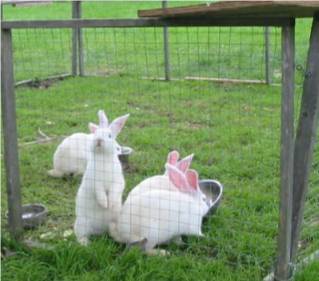
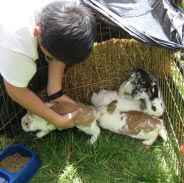 Comment:
Please don’t buy live bunnies as Easter gifts. They are over-exploited at this
time of year and end up unwanted as soon as the novelty has worn off. The
Rabbit Advocacy Group of BC has ongoing campaigns encouraging the public to act
responsibly and look to alternatives like a toy instead.
Comment:
Please don’t buy live bunnies as Easter gifts. They are over-exploited at this
time of year and end up unwanted as soon as the novelty has worn off. The
Rabbit Advocacy Group of BC has ongoing campaigns encouraging the public to act
responsibly and look to alternatives like a toy instead.
Frightened little rabbits cower into the corner of their pen at a petting zoo as a youngster reaches in to grab one. Petting zoo employees had left them unattended. Rabbits are sensitive critters and don’t like being handled. Breeders and operators of commercial enterprises exploit creatures for profit, and often travel with an assortment of animals to community events like those held at Eastertime.
June 12, 2013 Nearly 400 rabbits found in feces riddled garage
The breeder, Richard Cartheuser, has been warned before. He is the vice president of the National Mini Rex Rabbit Club.
June 20, 2013 Owner of 375 rabbits only gets 15 back
Comment: Cartheuser will have to be watched closely or he’ll be back in business again. That’s what he does – exploits and profits off the backs of these little creatures. Whether they were sold as meat, as pets, as “feeders” for reptiles, or displayed at “rabbit shows”, it was and is always about the bottom line.
January 30, 2015 Lauderdale County couple charged in hoarding case; more than 200 animals found on their property
February 10, 2015 UPDATE: Animals from hoarding case surrendered to district attorney
Comment: According to District Attorney Chris Connelly, the rabbits have been transferred to Andy High, who is the Lauderdale County coroner. High’s Facebook page and the American Rabbit Breeders Association identify him as a rabbit judge and breeder. According to his Facebook profile, High is a member of an online group “Carnivore Feed Supplier,” which displays graphic photos of dead, skinned rabbits.
Note: High has cleaned these references off his Facebook page.
Update #2: Andy High, the county coroner has callously and recklessly given away the confiscated rabbits to other breeders in Alabama and Tennessee, where they will be forced to breed in squalor for the rest of their lives. This is totally unacceptable! House Rabbit Society branches are willing to take in these rabbits. You can let your thoughts be known by contacting the District Attorney Chris Connelly.
In Defense of Animals has a form letter you can sign: https://secure2.convio.net/ida/site/Advocacy?cmd=display&page=UserAction&id=2726
April 22, 2015 SPCA seize rabbits found in 'horrendous' conditions
July 29, 2015 Officials removing 200 rabbits from pet business
